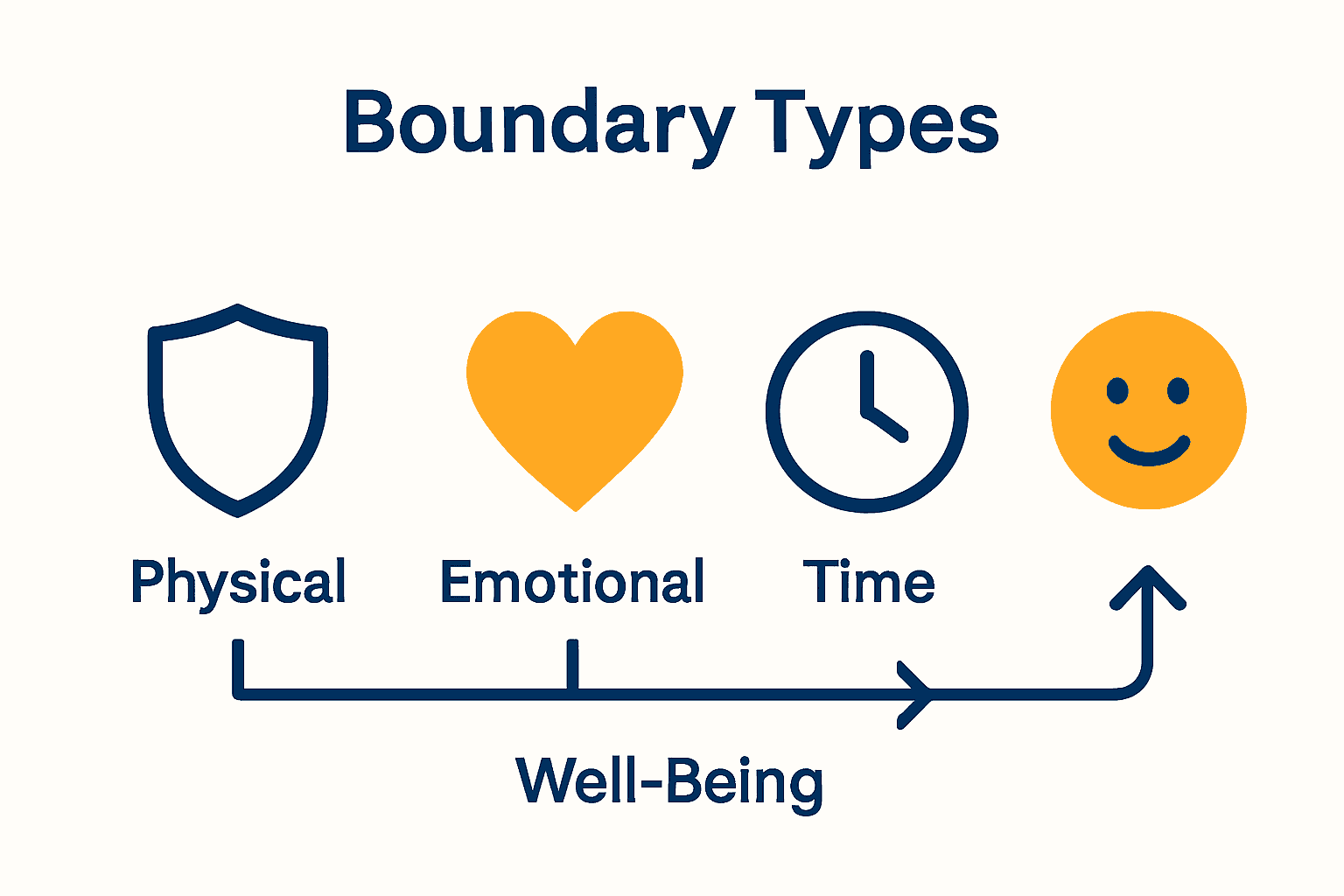Boundaries in Relationships: Complete Expert Guide

Did you know that nearly half of adults struggle to set personal boundaries in relationships? When these lines blur, misunderstandings and stress often take their place. Understanding healthy boundaries can help protect your emotional and mental well-being while keeping your closest connections strong. By learning which limits matter and how to express them, you can create more respectful, satisfying partnerships with less conflict and greater trust.
Table of Contents
- Defining Boundaries In Relationships
- Types Of Boundaries And Key Differences
- Healthy Boundaries: Characteristics And Benefits
- Common Boundary Challenges And Misconceptions
- Establishing And Enforcing Boundaries Effectively
- Conflict Resolution And Support Resources
Key Takeaways
| Point | Details |
|---|---|
| Understanding Boundaries | Personal boundaries are essential for healthy relationships, protecting emotional and psychological well-being while facilitating genuine connections. |
| Types of Boundaries | Key boundary types include physical, emotional, and time boundaries, each serving distinct roles in managing interactions and personal comfort. |
| Characteristics of Healthy Boundaries | Healthy boundaries demonstrate clear communication, mutual respect, and emotional self-awareness, enabling individuals to maintain their identities while fostering closeness. |
| Ongoing Process | Establishing and enforcing boundaries is a continuous dialogue requiring self-reflection, adaptability, and effective communication strategies. |
Defining Boundaries in Relationships
Personal boundaries represent the foundational framework that defines healthy interactions within relationships. At their core, boundaries are the invisible lines that protect your emotional, physical, and psychological well-being while allowing meaningful connections to flourish.
According to UHS Berkeley, “personal boundaries are the limits and rules we set for ourselves within relationships.” This definition highlights a critical aspect of boundary setting: it’s about creating a balanced approach where you can confidently say “no” when necessary while simultaneously remaining open to intimacy and genuine connection.
Healthy boundaries are not about building walls, but creating flexible guidelines that communicate your needs, values, and comfort levels. They serve multiple essential functions:

- Protect your emotional and mental energy
- Establish clear expectations in relationships
- Prevent potential misunderstandings
- Promote mutual respect between partners
- Reduce potential conflicts and resentment
As Utah State University Extension notes, “Every individual and every romantic relationship will have different boundaries that work best.” This means there’s no universal template for setting boundaries – they are deeply personal and must be tailored to your unique relationship dynamics.
To effectively establish boundaries, consider them as a collaborative process. Open, honest communication with your partner about individual needs, comfort levels, and expectations is crucial. This might involve discussing physical intimacy, personal space, communication preferences, financial decisions, or time management.
Remember that boundary setting is an ongoing conversation, not a one-time event. As relationships evolve, so too will your boundaries. Regular check-ins, mutual respect, and a willingness to adapt are key to maintaining healthy, dynamic relationship boundaries.
Types of Boundaries and Key Differences
Boundaries are not a one-size-fits-all concept, but rather a nuanced spectrum of personal protection and connection strategies. Boundary types represent different ways individuals manage their interpersonal interactions, emotional vulnerabilities, and personal space.
According to Utah State University Extension, three primary boundary categories exist: Physical, Emotional, and Time Boundaries. Each type serves a unique purpose in maintaining healthy relationships and personal well-being.
Here’s a comparison of the three main types of boundaries in relationships:
| Boundary Type | Key Focus Areas | Examples |
|---|---|---|
| Physical | Personal space Touch Autonomy |
Preferences for hugs Personal space at home Consent in intimacy |
| Emotional | Information sharing Emotional investment Vulnerability |
Not oversharing secrets Managing emotional triggers Setting limits on advice given |
| Time | Availability Work-life balance Commitments |
Scheduling alone time Balancing work and relationships Limiting social obligations |
Physical Boundaries
Physical boundaries involve personal space, touch, and bodily autonomy. These boundaries define:
- Acceptable forms of physical contact
- Personal comfort with intimacy
- Respect for physical and sexual preferences
- Protection against unwanted touch
Emotional Boundaries
Emotional boundaries protect psychological well-being by regulating:
- Information sharing
- Emotional energy investment
- Protection from manipulation
- Personal vulnerability management
Time Boundaries
Time boundaries help manage personal resources and prevent burnout by:
- Setting limits on availability
- Protecting personal and professional time
- Establishing healthy work-life balance
- Preventing over-commitment
As UHS Berkeley highlights, boundaries can manifest as rigid, porous, or healthy. Rigid boundaries might involve complete emotional isolation, while porous boundaries could mean excessive vulnerability and difficulty saying no.
Healthy boundaries represent a balanced approach – flexible enough to allow genuine connection while maintaining personal integrity.
They require consistent communication, self-awareness, and mutual respect. Understanding and implementing different boundary types can transform relationship dynamics, promoting deeper, more authentic connections.

Healthy Boundaries: Characteristics and Benefits
Healthy boundaries are the cornerstone of meaningful, respectful relationships that nurture personal growth and emotional well-being. They represent a dynamic, intentional approach to interpersonal interactions that prioritize self-respect, mutual understanding, and authentic connection.
According to UHS Berkeley, a person with healthy boundaries demonstrates several key characteristics:
- Values their own opinions
- Refuses to compromise core values for others
- Shares personal information appropriately
- Understands and communicates personal wants and needs
- Maintains a strong sense of self-identity
Key Characteristics of Healthy Boundaries
Healthy boundaries are characterized by:
- Clear and consistent communication
- Respectful self-assertion
- Emotional self-awareness
- Flexibility and adaptability
- Mutual respect and understanding
Benefits of Establishing Healthy Boundaries
The advantages of maintaining robust personal boundaries include:
- Enhanced self-esteem
- Reduced emotional stress
- Improved relationship quality
- Better conflict resolution skills
- Increased personal empowerment
As Utah State University Extension emphasizes, creating healthy boundaries is a gradual process. It takes time for partners to adapt to each other’s limits, and these boundaries will naturally evolve and grow over time.
Importantly, healthy boundaries are not about creating distance, but about fostering deeper, more authentic connections. They provide a framework for mutual respect, allowing individuals to maintain their unique identities while building intimate, supportive relationships. By consistently communicating and respecting each other’s boundaries, partners can create a strong foundation of trust, understanding, and emotional safety.
Common Boundary Challenges and Misconceptions
Establishing and maintaining healthy boundaries is rarely a straightforward process. Many individuals struggle with understanding, implementing, and sustaining effective personal boundaries due to deep-rooted misconceptions and emotional challenges.
According to UHS Berkeley, people with porous boundaries often exhibit problematic behavioral patterns, including:
- Oversharing personal information
- Difficulty saying ‘no’ to others’ requests
- Being excessively involved in others’ problems
- Compromising personal comfort for external validation
Common Boundary Misconceptions
Several widespread myths can undermine boundary-setting efforts:
- Boundaries are selfish
- Setting limits means you don’t care
- Healthy boundaries create emotional distance
- Compromise always means weakening boundaries
Emotional Triggers and Boundary Challenges
Emotional triggers can significantly complicate boundary maintenance:
- Childhood trauma
- Low self-esteem
- Fear of rejection
- People-pleasing tendencies
- Codependent relationship patterns
As Utah State University Extension highlights, relationship dynamics can become complicated when partners accidentally or intentionally cross emotional limits. Sensitive topics can quickly escalate into boundary violations if not approached with mutual respect and understanding.
Recognizing boundary challenges is the first step toward meaningful change. By understanding these common misconceptions and emotional barriers, individuals can develop more intentional, compassionate approaches to personal boundaries. The goal isn’t perfection, but progressive improvement in communication, self-awareness, and interpersonal respect.
Establishing and Enforcing Boundaries Effectively
Boundary establishment is an intentional, nuanced process that requires self-awareness, clear communication, and consistent practice. It’s not about creating walls, but about creating healthy, respectful frameworks for interpersonal interactions.
According to UHS Berkeley, using I-statements is crucial when communicating boundaries. For example, instead of saying “You always make me uncomfortable,” try “I feel unsafe when certain topics are discussed.”
Key Steps for Boundary Setting
Effective boundary establishment involves:
- Self-reflection on personal limits
- Clear, compassionate communication
- Consistent enforcement
- Willingness to adjust and adapt
- Maintaining emotional neutrality
Communication Strategies
Communicating boundaries requires:
- Using calm, direct language
- Avoiding blame or accusation
- Expressing needs without apology
- Listening to your partner’s perspective
- Remaining open to mutual understanding
As Utah State University Extension recommends, discussing physical boundaries involves openly conversing about personal space needs and comfort levels. This might mean negotiating physical proximity, touch preferences, or personal time requirements.
If you’re struggling with parental or relationship conflicts that intersect with boundary issues, check out our guide on managing parental conflicts. Boundary setting is a skill that improves with practice, patience, and mutual respect. Remember, the goal is creating relationships where both individuals feel valued, heard, and emotionally safe.
Conflict Resolution and Support Resources
Conflict resolution is a critical skill that transforms challenging interpersonal dynamics into opportunities for growth, understanding, and deeper connection. Navigating relationship challenges requires a combination of emotional intelligence, strategic communication, and professional support.
As Utah State University Extension emphasizes, creating healthy boundaries is a gradual process. Partners must be patient, recognizing that adapting to each other’s limits takes time and will continuously evolve throughout the relationship.
Professional Support Options
Various resources can help individuals and couples develop stronger conflict resolution skills:
- Individual counseling
- Couples therapy
- Online workshops
- Support groups
- Relationship coaching
Communication and Empathy Strategies
Effective conflict resolution involves:
- Active listening
- Expressing emotions constructively
- Practicing empathy
- Maintaining respectful dialogue
- Seeking mutual understanding
If you’re looking to enhance your conflict resolution skills, our comprehensive guide on conflict resolution strategies for couples provides practical techniques to navigate challenging conversations.
According to UHS Berkeley, context matters significantly in communication. What might be appropriate in one setting could be inappropriate in another, underscoring the importance of adaptability and situational awareness in resolving conflicts.
Take Control of Your Relationship Boundaries Today
Understanding and setting healthy boundaries is key to building stronger, more respectful connections. If you find it difficult to assert your emotional, physical, or time limits in relationships or want to deepen your communication skills, you are not alone. Many face challenges like fear of rejection or people-pleasing instincts that make boundary-setting complex. Mastering Conflict is here to help you navigate these challenges with confidence and compassion.

Explore expert guidance and personalized support with our couples therapy and individual counseling services designed to help you communicate clearly, enforce your boundaries, and foster mutual respect. Don’t wait until misunderstandings escalate into conflict. Visit Mastering Conflict now to start building healthier relationships through better boundaries and effective conflict resolution techniques. Your well-being and peace of mind are worth it.
Frequently Asked Questions
What are personal boundaries in relationships?
Personal boundaries are the limits and rules that individuals set for themselves within relationships to protect their emotional, physical, and psychological well-being while allowing for meaningful connections.
Why are healthy boundaries important in relationships?
Healthy boundaries are crucial as they protect personal integrity, establish clear expectations, prevent misunderstandings, promote mutual respect, and reduce potential conflicts and resentment.
What are the main types of boundaries in relationships?
The primary types of boundaries include physical boundaries (pertaining to personal space and touch), emotional boundaries (regarding emotional investment and vulnerability), and time boundaries (related to availability and work-life balance).
How can I effectively communicate my boundaries to my partner?
To effectively communicate boundaries, use clear and calm language, employ I-statements to express feelings without blaming, actively listen to your partner’s perspective, and maintain openness to ongoing dialogue and mutual understanding.
